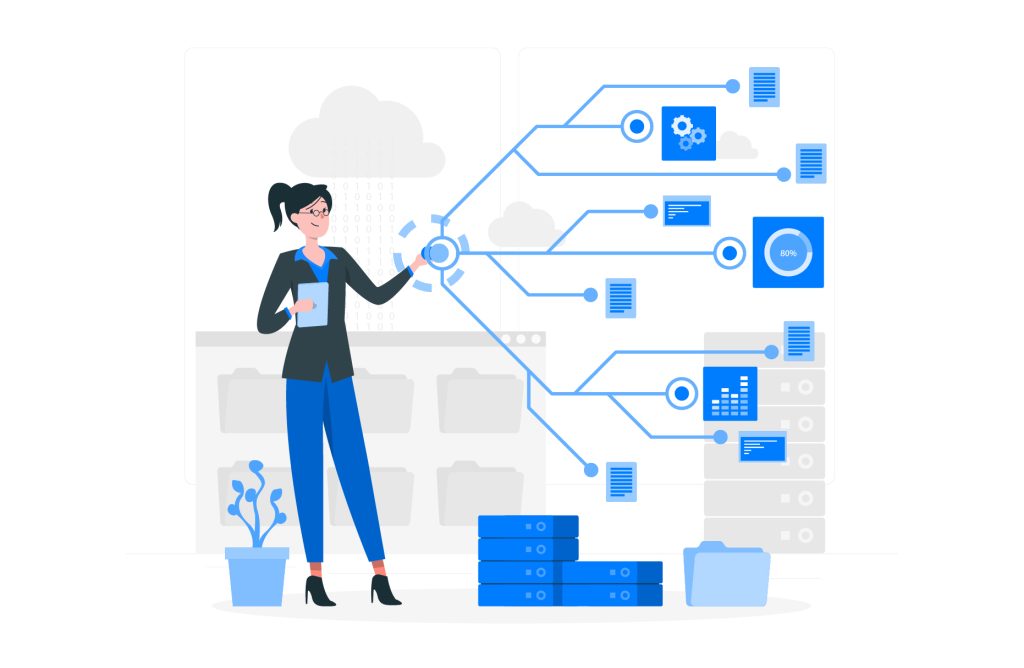BLOG
The Modern Data Stack: Revolutionizing Data Management and Analysis
What Is a Data Stack?
A data stack refers to the collection of technologies, tools, and processes used to manage and analyse data within an organization. It is a comprehensive framework that encompasses the entire data ecosystem, from data ingestion to data storage, processing, integration, analysis, and visualization.
In a data stack, different components work together to handle various aspects of data management and analysis, enabling organizations to derive insights, make informed decisions, and gain a competitive edge. The specific components and technologies within a data stack can vary depending on the organization’s requirements, infrastructure, and data strategy.

What are the main functions of data stacks?
The main functions of a data stack include the following:
Data Collection:
Data stacks enable the collection of data from various sources, such as databases, APIs, files, and streaming platforms. This involves extracting data in its raw form and preparing it for further processing.
Data Transformation and Integration:
Once data is collected, it often needs to be transformed and integrated to make it usable for analysis. Data stacks provide tools for cleaning, validating, standardizing, and enriching data. They also facilitate data integration, allowing data from multiple sources to be combined and consolidated.
Data Storage:
Data stacks include data storage systems where data can be stored securely and efficiently. This may involve traditional relational databases, NoSQL databases, data lakes, or data warehouses. The choice of data storage depends on factors such as data volume, structure, latency requirements, and analysis needs.
Data Processing and Analysis:
Data stacks enable the processing and analysis of data to derive insights and make data-driven decisions. They offer tools for data exploration, data manipulation, statistical analysis, machine learning, and advanced analytics techniques. These tools help uncover patterns, trends, correlations, and anomalies within the data. It includes tasks such as data transformation, data enrichment, data aggregation, and data integration, often using techniques like Extract Transform Load (ETL) or Extract Load Transform (ELT) processes.
Data Visualization and Reporting:
Data stacks provide tools for visualizing and presenting data in meaningful ways. Visualization tools allow users to create charts, graphs, dashboards, and reports to communicate insights effectively. This enables stakeholders to understand complex data and make informed decisions.
Data Governance and Security:
Data stacks incorporate mechanisms for data governance and security. They include features for managing data access, ensuring data quality, enforcing data privacy and compliance with regulations. These features help maintain data integrity, protect sensitive information, and meet regulatory requirements.
Data Pipelines and Automation:
Data stacks facilitate the creation of data pipelines, which automate the flow of data from source to destination. This involves defining workflows, scheduling data extraction and transformation processes, and managing dependencies. Data pipelines ensure the efficient and timely processing of data.
Scalability and Performance:
Data stacks are designed to handle large volumes of data and scale as data grows. They provide mechanisms for distributing and parallel processing of data to ensure high performance and responsiveness. This allows organizations to handle increasing data demands and support real-time analytics.
Integration with External Tools and Systems:
Data stacks often offer integrations with external tools and systems, such as business intelligence platforms, data governance tools, workflow management systems, and cloud services. This enables seamless data flow and collaboration across different parts of the organization’s technology ecosystem.

What are the advantages of a Modern Data Stack?
A modern data stack offers several advantages over traditional approaches to data management and analysis. Some of the key advantages include:
Scalability:
Modern data stacks are designed to handle large volumes of data and scale seamlessly as data grows. They leverage distributed computing and cloud-based infrastructure to accommodate increasing data demands without compromising performance.
Flexibility:
A modern data stack provides flexibility in terms of data types and sources. It can handle structured and unstructured data from various sources such as databases, APIs, streaming platforms, and files. This flexibility enables organizations to harness diverse data sets and gain a comprehensive view of their operations.
Agility:
Traditional data architectures often involve complex and rigid processes for data integration, transformation, and analysis. In contrast, modern data stacks embrace agile methodologies and tools that allow for faster iterations, shorter development cycles, and more rapid deployment of data pipelines and analytics solutions.
Cost-effectiveness:
Modern data stacks leverage cloud computing resources, eliminating the need for organizations to invest heavily in on-premises infrastructure. This reduces upfront costs and provides the flexibility to scale resources up or down based on actual conditions. It also minimizes the costs associated with hardware maintenance, upgrades, and system administration.
Real-time and near real-time analytics:
Modern data stacks enable real-time or near real-time analytics, allowing organizations to derive insights from data as it is generated. This capability is especially valuable in scenarios where immediate action or response is required, such as fraud detection, predictive maintenance, or real-time monitoring of customer behaviour.
Data-driven decision-making:
By providing tools for data exploration, visualization, and advanced analytics, modern data stacks empower organizations to make data-driven decisions. They enable business users to easily access and analyse data, uncover patterns and trends, and gain actionable insights. This promotes a culture of evidence-based decision-making across the organization.
Integration with external tools and systems:
Modern data stacks often offer seamless integration with external tools and systems, such as business intelligence platforms, data visualization tools, data governance solutions, and machine learning frameworks. This integration allows organizations to leverage existing investments and extend the functionality of their data stack to meet specific business requirements.
Data governance and security:
Modern data stacks include built-in features and mechanisms for data governance and security. They provide capabilities for managing data access, enforcing data privacy, ensuring compliance with regulations, and maintaining data quality. These features help organizations establish robust data governance practices and protect sensitive information.
Collaboration and self-service analytics:
Modern data stacks promote collaboration and self-service analytics by providing intuitive interfaces and user-friendly tools. Business users, data analysts, and data scientists can collaborate more effectively, explore data independently, and generate insights without heavy reliance on IT or data engineering teams.
What is the difference between a data stack and a tech stack?
Here’s a breakdown of the key differences between a data stack and a tech stack:
Purpose:
Data Stack: A data stack refers to a collection of tools, technologies, and processes used to manage and analyse data effectively. It focuses specifically on data management, data integration, data processing, analytics, and visualization.
Tech Stack: A tech stack, also known as a technology stack or software stack, refers to the combination of software technologies, frameworks, programming languages, and tools used to develop and deploy applications or software systems. It encompasses all the layers and components required for application development, including frontend, backend, database, and infrastructure.
Scope and Components:
Data Stack: A data stack typically includes components such as data collection and extraction tools, data transformation and integration tools, data storage systems (such as databases, data lakes, or data warehouses), analytics and visualization tools, data governance and security mechanisms, and data pipeline orchestration tools.
Tech Stack: A tech stack covers a broader range of components necessary for application development. It includes frontend technologies (HTML, CSS, JavaScript, frameworks like React or Angular), backend technologies (programming languages like Python, Java, or Node.js, frameworks like Django or Express), databases (MySQL, PostgreSQL, MongoDB), web servers, APIs, and infrastructure components (cloud services, hosting platforms, containerization tools).
Focus and Functionality:
Data Stack: The primary focus of a data stack is to enable efficient management, processing, and analysis of data to derive insights and support data-driven decision-making. It provides tools and processes specifically designed for data management, analytics, and visualization.
Tech Stack: A tech stack is designed to support application development, encompassing all the necessary components and frameworks required to build functional software systems. It focuses on the development, deployment, and maintenance of applications or software solutions.
Data-Centric vs. Application-Centric:
Data Stack: A data stack is more data-centric, emphasizing the efficient handling and analysis of data. It addresses the challenges and complexities associated with managing large volumes of data, ensuring data quality, and extracting valuable insights from data.
Tech Stack: A tech stack is application-centric, focusing on building and delivering software solutions that meet specific functional requirements. It addresses the challenges of developing robust, scalable, and user-friendly applications.
What are the types of data stacks?
There are various types of data stacks available, each with its own set of tools and technologies. The specific type of data stack used by an organization depends on its data management and analysis needs. Here are some common types of data stacks:
Traditional Data Stack:
Relational Database Management System (RDBMS): MySQL, PostgreSQL, Oracle
Data Integration Tools: Informatica, Talend, SSIS
Business Intelligence (BI) Tools: Tableau, Power BI, QlikView
Extract, Transform, Load (ETL) Tools: Informatica PowerCenter, Talend, SSIS
Data Warehousing: Oracle Data Warehouse, Snowflake, Amazon Redshift
Hadoop Data Stack:
Hadoop Distributed File System (HDFS)
Apache Hadoop: MapReduce, Hadoop Distributed File System (HDFS)
Data Processing Frameworks: Apache Spark, Apache Hive, Apache Pig
NoSQL Databases: Apache Cassandra, MongoDB, Apache HBase
Data Integration and ETL: Apache NiFi, Apache Sqoop
Cloud Data Stack:
Cloud Storage: Amazon S3, Google Cloud Storage, Azure Blob Storage
Data Warehouses: Amazon Redshift, Google BigQuery, Snowflake
Serverless Data Processing: AWS Lambda, Google Cloud Functions
Cloud-based Analytics: Google Analytics, AWS Analytics Services
Data Pipeline Orchestration: Apache Airflow, AWS Glue, Google Cloud Dataflow
Real-Time Data Stack:
Stream Processing Frameworks: Apache Kafka, Apache Flink
Real-Time Analytics: Apache Druid, Apache Samza
In-Memory Data Stores: Redis, Apache Ignite
Complex Event Processing (CEP): Apache Storm, Esper
Real-Time Dashboards: Grafana, Kibana
Modern Data Stack:
Cloud-based Data Warehouses: Snowflake, Google BigQuery
Extract, Load, Transform (ELT) Tools: Stitch, Fivetran
Data Visualization and Analytics: Looker, Mode Analytics
Workflow and Data Orchestration: Apache Airflow, Prefect
Catalogue and Governance: Collibra, Alation
Data Science and Machine Learning Stack:
Data Science and Analytics Tools: Python, R, Jupyter Notebook
Machine Learning Frameworks: TensorFlow, PyTorch, scikit-learn
Model Deployment and Serving: Docker, Kubernetes, TensorFlow Serving
Model Monitoring and Management: MLflow, Kubeflow
Automated Machine Learning: AutoML, H2O.ai, DataRobot

How do you create a data stack?
Creating a data stack involves several steps and considerations. Here’s a high-level overview of the process:
Define Business Goals and Data Requirements:
Start by understanding the business goals and objectives that the data stack should support. Identify the key data requirements necessary to achieve those goals. Consider the types of data needed, data sources, data volume, data quality requirements, and the desired outcomes from data analysis.
Assess Existing Infrastructure:
Evaluate your existing technology infrastructure, including databases, data sources, storage systems, analytics tools, and any data processing or integration solutions already in place. Determine if any components can be reused or integrated into the new data stack.
Identify Tools and Technologies:
Research and select the appropriate tools and technologies that align with your data requirements and business goals. Consider components such as data storage systems (data warehouses, data lakes, or cloud-based storage), data integration tools (ETL or ELT), data processing frameworks, analytics and visualization platforms, and workflow orchestration tools.
Design Data Architecture:
Design a data architecture that outlines the flow of data within your organization. Define the data pipelines, data transformation processes, and the integration points between different components of the data stack. Consider factors such as data ingestion, data transformation, data storage, data modelling, and data access.
Implement Data Infrastructure:
Set up the infrastructure required to support the data stack. This may involve provisioning servers or cloud resources, configuring databases or data storage systems, installing necessary software components, and establishing connectivity between different components.
Data Integration and ETL/ELT Processes:
Implement data integration processes to extract data from various sources and transform it into a unified format suitable for analysis. This may involve developing ETL/ELT workflows, mapping data fields, cleaning data, and ensuring data consistency and quality.
Data Storage and Management:
Set up the data storage system that best suits your needs, such as a data warehouse, data lake, or a combination of both. Define the data schema, implement appropriate data models, and establish mechanisms for data organization, indexing, and retrieval.
Analytics and Visualization:
Configure the analytics and visualization tools within the data stack. This may involve connecting data sources, creating data models or cubes, designing dashboards, and defining key performance indicators (KPIs) or metrics for analysis.
Data Governance and Security:
Implement data governance practices and security measures to ensure data privacy, compliance with regulations, and protection against unauthorized access. Establish data access controls, data masking or encryption techniques, and implement mechanisms for data lineage and auditing.
Monitor and Iterate:
Regularly monitor the performance and effectiveness of your data stack. Identify areas for improvement, such as optimizing data processing workflows, enhancing data quality, or incorporating new tools or technologies as needed. Continuously iterate and refine your data stack to align with evolving business needs and technological advancements.
Example of a data stack tool?
There are several tools available in the market that can be used to build a data stack. The specific tools you choose will depend on your organization’s requirements, budget, and technology stack. Here are some examples of popular data stack tools:
Data Integration and ETL/ELT:
Apache Kafka: A distributed streaming platform for real-time data ingestion and messaging.
Apache NiFi: An easy-to-use data integration and ETL tool for data flow management.
Talend: A comprehensive data integration platform with ETL and ELT capabilities.
Informatica PowerCenter: An enterprise-grade ETL tool for data integration and transformation.
Data Storage and Data Warehousing:
Amazon Redshift: A fully-managed data warehouse service in the cloud.
Google BigQuery: A serverless, highly scalable data warehouse for analytics workloads.
Snowflake: A cloud-native data platform that combines data warehousing and data lake capabilities.
Apache Cassandra: A distributed NoSQL database for handling large-scale data sets.
Data Processing and Analytics:
Apache Spark: A fast and scalable data processing engine for big data analytics.
Hadoop: An open-source framework for distributed processing and storage of large datasets.
Google Cloud Dataflow: A fully managed service for real-time and batch data processing.
Apache Flink: A stream processing framework for high-throughput, low-latency analytics.
Data Visualization and Business Intelligence:
Tableau: A leading data visualization and business intelligence platform.
Power BI: A business analytics service by Microsoft for interactive data visualization and reporting.
Looker: A modern data platform for exploring, visualizing, and sharing insights.
QlikView: A self-service business intelligence and visualization tool.
Workflow Orchestration and Automation:
Apache Airflow: A platform to programmatically author, schedule, and monitor workflows.
Luigi: A Python-based workflow management system for data pipelines.
Apache Oozie: A workflow scheduler for managing Hadoop jobs and data processing tasks.
Data Governance and Security:
Collibra: A data governance and cataloguing platform for managing data assets and data privacy.
Apache Atlas: A scalable and extensible metadata management platform for data governance.
Okera: A data access platform that provides fine-grained access control and data masking.
Privacera: A data privacy and access control solution for secure data governance.
It’s important to note that the choice of tools may vary depending on your specific requirements, and new tools are constantly emerging in the data stack ecosystem. Consider factors such as integration capabilities, scalability, ease of use, community support, and compatibility with your existing infrastructure while selecting tools for your data stack.
What are the 6 applications of the modern stack?
A stack is a fundamental data structure that follows the Last-In-First-Out (LIFO) principle. Stacks have numerous applications across various domains. Here are six common applications of stacks:
Function Call Stack:
Stacks are extensively used in programming languages to manage function calls and track their execution. When a function is called, its execution context, including local variables and return address, is pushed onto the stack. The stack ensures that the function calls are executed in a nested manner, with the most recently called function being executed first.
Expression Evaluation:
Stacks play a crucial role in evaluating arithmetic expressions, especially those involving parentheses. When an expression is parsed, operators and operands are pushed onto the stack based on their precedence. The stack helps in maintaining the correct order of evaluation and ensures that parentheses are matched correctly.
Undo/Redo Operations:
Many applications, such as text editors, graphics software, or command-line interfaces, provide undo and redo functionality. Stacks are used to store the sequence of actions performed by the user. Each action is pushed onto the stack, allowing for easy undoing, and redoing of operations in the reverse order.
Backtracking Algorithms:
Backtracking algorithms involve exploring all possible solutions for a problem by recursively trying different choices. Stacks are used to store the states or decisions made at each step of the algorithm. If a choice leads to a dead-end, the algorithm backtracks by popping the stack and trying an alternative.
Browser History:
Web browsers maintain a history of visited web pages to facilitate navigation. Stacks are used to store the browsing history. Each visited page is pushed onto the stack, enabling the user to navigate back to the previously visited pages by popping the stack.
Depth-First Search (DFS) Algorithm:
DFS is a graph traversal algorithm used to explore nodes in a graph or tree structure. Stacks are utilized to keep track of the nodes being visited and their neighbours. The algorithm visits a node, pushes its unvisited neighbours onto the stack, and continues exploring the graph until all nodes have been visited.
Conclusion:
The Modern Data Stack has revolutionized the way organizations manage and analyse data, providing a comprehensive framework for data management, analysis, and visualization. By leveraging its powerful components—data extraction and transformation, data warehousing, analytics, and visualization—organizations can unlock the full potential of their data assets, make data-driven decisions, and gain a competitive edge.
Implementing the Modern Data Stack requires careful planning, collaboration, and the proper selection of tools and technologies tailored to your organization’s specific needs. By following the steps outlined in this blog post, you can embark on a data-driven journey that empowers your organization to harness the true value of data and drive success.
Remember, the Modern Data Stack is not a one-size-fits-all solution. Continuously assess your data needs, evaluate emerging technologies, and adapt your data stack accordingly to stay at the forefront of data management and analysis.
Embrace the power of the Modern Data Stack and unlock new possibilities for your organization’s data-driven future.
Related Topics
Trending Topics
Want to build Super app for your business?



